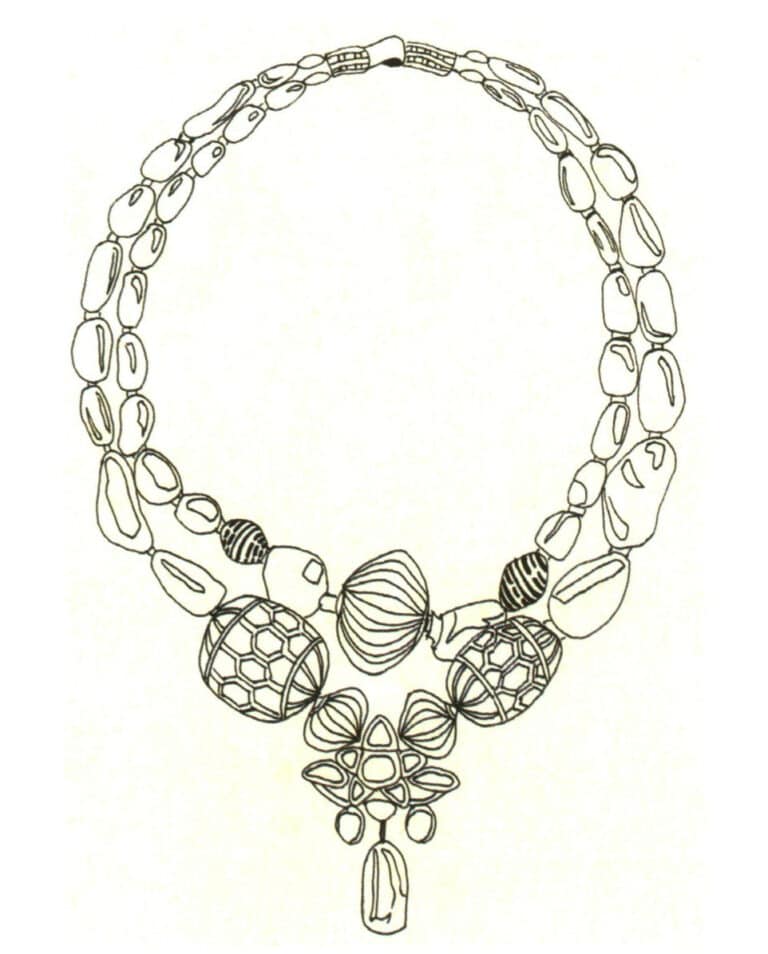세계에서 가장 큰 다이아몬드는 어디에서 찾을 수 있나요?
세계에서 가장 큰 다이아몬드: 보츠와나, 시에라리온, 레소토 및 글로벌 광산
소개:
세계에서 가장 큰 다이아몬드의 원산지가 어디인지, 어떻게 전설적인 주얼리가 되는지 궁금한 적이 있나요? 이 가이드에서는 아프리카 광산에서 발견된 1,758캐럿의 보츠와나 세웰로와 910캐럿의 레소토 레전드와 같은 특별한 러프 다이아몬드의 발견부터 세심한 커팅과 연마까지 그 여정을 살펴보세요. D 컬러와 완벽한 선명도, 그라프와 해리 윈스턴 같은 유명 하우스의 인수에 대해 알아보세요. 주얼리 디자이너, 소매업체 및 브랜드에게는 고급 맞춤형 제품 및 독점 컬렉션을 위한 희귀한 보석 소싱에 대한 필수적인 통찰력을 제공합니다.

목차
섹션 I 보츠와나에서 생산된 초대형 다이아몬드
1. 희귀 세웰로 다이아몬드
(1) 희귀 세웰로 다이아몬드의 네이밍
2019년 4월 19일, 보츠와나의 카로웨 다이아몬드 광산에서 희귀 다이아몬드인 세웰로 다이아몬드가 발견되었습니다. 이 다이아몬드의 무게는 1,758캐럿, 크기는 83mm×62mm×46mm, 색상은 매우 짙고 테니스공 크기 정도였습니다(그림 5-27). 광산 소유주인 캐나다 회사 루카라 다이아몬드 코퍼레이션은 보츠와나 국민을 초대하여 이름을 짓는 데 참여하도록 했습니다. 총 22,000개의 이름 중 "세웨로"(세츠와나어로 "희귀한 발견"이라는 뜻)가 선정되어 보츠와나 대통령이 참석한 명명식에서 발표되었습니다. 이 다이아몬드는 보츠와나에서 발견된 다이아몬드 중 가장 크고 세계에서 컬리넌 다이아몬드에 이어 두 번째로 큰 다이아몬드입니다.
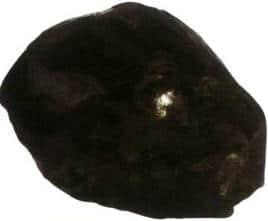
(2) 세웰로 다이아몬드의 특성 및 커팅
외관상으로는 다이아몬드의 색상이 어둡게 보이지만, 예비 분석에 따르면 이 다이아몬드는 고품질의 화이트 다이아몬드 소재를 함유한 보석급 다이아몬드이며, 당분간 이 다이아몬드에 대한 면밀한 연구가 계속될 예정입니다. 다이아몬드 표면은 얇은 탄소층으로 덮여 있어 외관은 검은색이지만 다이아몬드 내부의 색상과 투명도는 가변적입니다.
세계적인 명품 기업 루이 비통은 루카라와 벨기에 앤트워프 다이아몬드 제조업체 HB와 협력하여 희귀한 세웰로 다이아몬드를 보석 수준의 스톤으로 커팅 및 폴리싱하여 "완전한 잠재력"을 드러낼 것이라고 발표했습니다. 이는 루이 비통의 위험을 감수하려는 의지와 창의성을 반영하는 것으로, 이 다이아몬드는 매우 희귀하고 파격적이며 도전적이고 특별합니다.
루이 비통은 앤트워프 다이아몬드 제조업체와 긴밀히 협력하여 다이아몬드의 세부 사항을 연구하고 최신 스캐닝 및 이미징 기술을 사용하여 최고의 수율과 최고의 폴리싱 컷 품질을 목표로 다이아몬드의 최종 커팅 계획을 평가하고 있습니다. 커팅의 첫 번째 단계는 다이아몬드에 창을 연마하여 내부 특징을 관찰하고 컷의 모양, 크기, 색상 범위를 설계하는 것입니다. 다이아몬드 커팅은 기술, 전문성, 직관이 결합된 고대의 신비로운 예술입니다. 초기 스캐닝과 디자인부터 커팅과 연마에 이르기까지 전체 공정에 걸쳐 첨단 첨단 기술이 중요한 역할을 하며, 완료까지 1년이 소요될 것으로 예상됩니다.
2. 레세디 라 로나 다이아몬드
(1) 레세디 라 로나 다이아몬드의 발견
레세디 라 로나 다이아몬드는 2015년 11월 보츠와나의 카로웨 다이아몬드 광산에서 1109캐럿의 무게로 발견되었습니다. 캐나다에 본사를 둔 루카라 다이아몬드사가 이 다이아몬드를 소유하고 있습니다. 이 다이아몬드의 크기는 (그림 5-28) 65mm×56mm×40mm이며, 테니스공 크기 정도의 투명하고 반짝이는 외관을 가졌습니다. 이 다이아몬드는 컬리넌 다이아몬드 이후 1세기 이상 만에 발견된 1,000캐럿 이상의 거대 다이아몬드입니다. 다이아몬드 분석가들은 이 다이아몬드의 가치를 수천만 달러로 추정했습니다. "레세디 라 로나"는 츠와나어로 "우리의 빛"이라는 뜻으로, 보츠와나의 자부심이자 빛이며 희망이라는 의미를 담고 있습니다.

(2) 레세디 라 로나 다이아몬드 커팅
보석학자와 다이아몬드 커팅 팀은 총 18개월에 걸친 면밀한 연구, 분석, 커팅, 연마 과정을 거쳐 컴퓨터 시뮬레이션 커팅을 기반으로 이 매우 큰 러프 다이아몬드에서 하나의 대형 다이아몬드와 66개의 완제품 스톤을 생산해냈습니다.
이 중 가장 큰 다이아몬드는 "그라프 레세디 라 로나" 다이아몬드(그림 5-29)로, 302.37캐럿의 정사각형 에메랄드 컷 스타일로 커팅되었으며, 현재까지 이 컷의 다이아몬드 중 세계에서 가장 큰 다이아몬드입니다. 미국 보석 연구소(GIA)는 이 다이아몬드에 매우 높은 선명도와 뛰어난 광택 및 대칭성을 갖춘 컬러 등급을 부여했습니다.
레세디 라 로나 러프 다이아몬드의 모든 완성된 다이아몬드 컷은 GIA의 테스트와 컬러 등급을 받았으며, 각 다이아몬드에는 "그라프" 및 "레세디 라 로나"와 독점 GIA 번호(그림 5-30)가 거들에 레이저로 새겨져 있습니다.
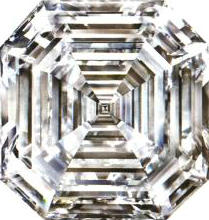
그림 5-29 그라프 - 레세디 라 로나 다이아몬드

그림 5-30 거들에 각인이 있는 완성된 다이아몬드
3. 컨스텔레이션 다이아몬드
(1) 컨스텔레이션 다이아몬드의 발견 및 소유권
컨스텔레이션 다이아몬드는 2015년 11월 보츠와나의 카로웨 다이아몬드 광산에서 발견되었습니다. 이 다이아몬드의 무게는 813캐럿, 크기는 최대 60mm에 달했으며 색과 선명도가 뛰어났습니다(그림 5-31). 2016년 5월, 치열한 경매 입찰 끝에 스위스의 드 그리소고노가 두바이의 네메시스 인터내셔널과 제휴하여 $63백만 달러에 매입했습니다. 캐럿당 가격은 약 $77,613달러로, 지금까지 판매된 다이아몬드 중 가장 비싼 가격입니다.

(2) 별자리 다이아몬드 커팅
드 그리소고노의 설립자이자 이사회 멤버인 파와즈 그루오시는 이렇게 말했습니다: "컨스텔레이션 다이아몬드를 만나게 된 것은 말로 표현할 수 없을 정도로 감격스러운 일생일대의 사건입니다. 주얼리 디자이너로서 이 유명한 다이아몬드와 이 보석을 얻기 위해 열심히 노력한 팀 동료들을 결코 배신할 수 없었고, 다이아몬드의 커팅과 세팅에 제 창의적인 기술을 접목할 수 있게 되어 큰 영광이며 하루빨리 제작을 시작하고 싶습니다."라고 말했습니다.
더 그리컨스 컴퍼니는 이 다이아몬드를 구매함으로써 최고급 다이아몬드 홍보 및 판매의 이점을 강화하고, 세계 희귀 보석을 수집하고 주얼리 걸작을 만들겠다는 의지를 보여줌으로써 브랜드 이미지를 강화할 수 있습니다. 이 회사는 이 귀중한 다이아몬드의 커팅 과정에 직접 참여하여 독특한 창의성과 정교한 장인 정신을 결합하여 고객에게 일생일대의 보물을 만들 수 있습니다.
컨스텔레이션 다이아몬드의 커팅은 네메시스의 계열사인 알마스 다이아몬드 서비스에서 완료되었으며 총 18개월이 소요되었습니다. 이 원석에서 8개의 완성된 다이아몬드가 절단되었으며, 그 중 가장 큰 다이아몬드의 무게는 313캐럿(그림 5-32)이고, D 컬러이며, 투명도는 VVS1입니다. 두 번째로 큰 다이아몬드의 무게는 102캐럿입니다.
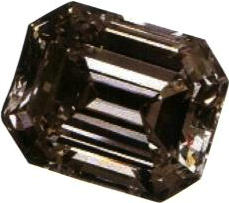
4. 아직 이름 없는 거대한 다이아몬드
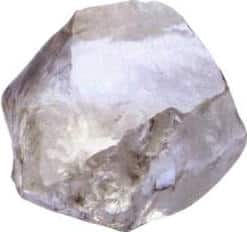
5. 신비한, 이름 없는, 매우 큰 다이아몬드

섹션 II 시에라리온에서 생산되는 예외적으로 큰 다이아몬드
1. 시에라리온 스타 다이아몬드
(1) 시에라리온의 별 다이아몬드 발견
시에라리온의 별 다이아몬드는 1972년 2월 14일, 시에라리온 동부 코노 지역 코이두 마을 디민코의 충적층에서 시에라리온인 E. O. 윌리엄스에 의해 발견되었습니다. 발견 당시 이 다이아몬드는 969.80캐럿으로 세계에서 세 번째로 큰 천연 다이아몬드로 알려져 있었습니다(그림 5-35). 이 다이아몬드는 깨끗하고 불규칙한 모양을 하고 있었으며, 단일 타입 IIa 다이아몬드로 분류되었습니다.

(2) 시에라리온의 별 다이아몬드 절단 및 연마
1972년 10월 3일, 당시 시에라리온 대통령 시아카 프로빈 스티븐스는 미국의 유명 보석상 해리 윈스턴이 시에라리온의 별 다이아몬드를 $250만 달러에 구입했다고 발표했습니다. 이 다이아몬드는 처음에 143.20캐럿의 에메랄드 컷으로 하나의 완성된 스톤으로 커팅되었으나 내부 결함으로 인해 이후 재커팅을 거쳤습니다. 시에라리온의 별은 총 17개의 완성된 다이아몬드로 절단되었으며, 그 중 13개의 다이아몬드는 흠잡을 데 없이 완벽했습니다. 가장 큰 완성 다이아몬드는 53.96캐럿의 무게와 완벽한 투명도, 배 모양을 가지고 있었습니다. 이 러프에서 컷팅한 6개의 완성된 다이아몬드는 나중에 해리 윈스턴이 시에라리온의 별 브로치로 세팅했습니다.
2. 워이 리버 다이아몬드
역시 시에라리온에서 생산된 워이강 다이아몬드는 770.00캐럿의 대형 순백색 다이아몬드입니다. 이 다이아몬드는 1945년 시에라리온의 워이강 충적층에서 발견되었습니다. 이 다이아몬드가 발견된 강에서는 각각 532.00캐럿과 249.50캐럿의 다른 두 개의 다이아몬드도 발견되었는데, 이 다이아몬드는 먼 원산지에서 강을 통해 운반되었지만 아직 원산지는 발견되지 않았습니다. 워이강 다이아몬드는 런던에서 브리프텔과 레머에 의해 총 30개의 다이아몬드가 커팅되었으며, 가장 큰 다이아몬드는 에메랄드 컷의 31.35캐럿으로 빅토리 다이아몬드(그림 5-36)로 명명되었습니다.
미국 보석 연구소(GIA)의 평가에 따르면, 이 다이아몬드는 VVS2의 투명도를 지닌 D 등급을 받았습니다. 2015년 12월, 뉴욕 크리스티 경매에서 $4,039,000에 낙찰되었습니다.

3. 피스 다이아몬드
(1) 피스 다이아몬드의 발견
2017년 3월 시에라리온 동부 코노 지역의 코리아두 충적 광산에서 발견된 피스 다이아몬드의 무게는 709.41캐럿이었습니다(그림 5-37). 달걀 크기의 이 다이아몬드는 엠마누엘 모모 목사의 도움으로 5명의 광부들이 회수했습니다.

(2) 피스 다이아몬드 경매
2017년 12월, 시에라리온 정부는 이 다이아몬드를 처음으로 공개 경매에 부쳤고, 70여 명의 잠재적 구매자가 몰렸습니다. 7차례의 입찰 끝에 영국 보석상인 로렌스 그라프가 미화 $650만 달러에 최종 낙찰받았습니다. 경매 수익금의 59%는 다이아몬드 생산 지역의 인프라를 개선하고 주민들에게 깨끗한 식수와 안전한 의료 서비스를 제공하기 위해 시에라리온 국고에 예치되었습니다. 이번 경매를 통해 광부들이 채굴한 다이아몬드를 암시장에 판매하지 않고 정부에 넘겨 공매를 받도록 장려할 것이며, "이는 시에라리온의 새로운 시대의 시작이 될 수 있다"고 말했습니다.
다이아몬드 낙찰자인 로렌스 그라프는 이렇게 말했습니다: "이 특별한 다이아몬드를 낙찰받게 되어 매우 영광이며, 이번 거래는 긴급한 도움이 필요한 시에라리온에 직접적인 도움이 될 것입니다. 이 아름다운 보석을 생산하는 지역에 환원할 수 있다는 것은 특히 의미 있는 일입니다. 우리가 만나는 모든 아름다운 다이아몬드는 우리의 엄청난 열정과 전문성을 반영합니다. 이제 그라프의 보석 감정 전문가들이 이 자연의 경이로움에 숨겨진 아름다움을 발견하기 위해 다이아몬드 감정에 착수할 것입니다."
4. 세파두 다이아몬드
5. 마야 번영 다이아몬드
(1) 메야 번영 다이아몬드의 발견
메야 프로스퍼티 다이아몬드는 2017년 시에라리온 동부의 코노 지역에 있는 메야 광산에서 발견되었습니다. 원석의 무게는 476캐럿이었습니다(그림 5-38). 이 다이아몬드의 발견은 이 지역의 밝은 미래를 열었으며, 시에라리온에 큰 변화와 발전의 기회를 가져다줄 것입니다.
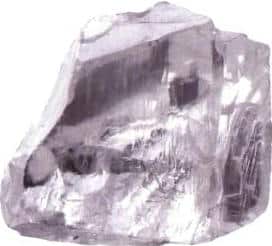
(2) 메야 번영 다이아몬드 거래
메야 마이닝의 CEO인 얀 주베르(Jan Joubert)는 이렇게 말했습니다: "로렌스 그라프와 '메야 프로스퍼티' 다이아몬드 판매에 합의하게 되어 기쁘게 생각합니다. 수많은 희귀하고 아름다운 다이아몬드를 소유한 그의 현명한 리더십은 이 거친 원석에 완벽한 스토리를 만들어낼 수 있습니다. 파트너는 당사의 핵심 가치와 비전, 즉 높은 투명성, 책임감, 무결성을 이해해야 합니다. 그라프가 바로 그 확실한 선택입니다."
2017년, 로렌스 그라프는 "레세디 라 로나", "피스", "메야 프로스퍼티", 373캐럿의 러프 다이아몬드를 매입했습니다. 그는 "그라프는 올해 역사상 가장 중요한 다이아몬드 4개를 매입했으며, 이 희귀한 보물들을 보호하는 일을 맡게 되어 매우 영광입니다. 이제 그라프의 전문가 팀은 메야 프로스퍼티 다이아몬드를 연구하는 데 전념하여 이 경이로운 다이아몬드의 잠재력을 발견하기 위해 노력할 것입니다. 다른 전설적인 보석과 마찬가지로 모든 단계를 신중하게 고려할 것입니다. 앞으로 몇 달 동안 이 귀중한 다이아몬드의 커팅 및 폴리싱 방법을 결정할 예정이며, 이는 매우 흥미로운 일입니다. 머지않은 미래에 우리는 다시 한 번 비교할 수 없는 진귀한 다이아몬드를 세상에 선보일 것입니다."
6. 잘레 평화의 빛 다이아몬드
(1) 잘레 평화의 빛 다이아몬드 발견
잘레 라이트 오브 피스 다이아몬드는 1969년 시에라리온 동부의 세와강 유역에서 발견되었습니다. 이 다이아몬드는 옅은 청백색의 맑고 투명한 파편 형태로 발견되었으며, 대략적인 무게는 434.60캐럿이었습니다.
(2) 평화의 빛 다이아몬드 자르기
1969년 미국 텍사스 주 댈러스의 Zale Corporation은 벨기에 앤트워프에서 이 다이아몬드를 구입했습니다.
1971년, 신중한 계획 끝에 미국 뉴욕에서 컷팅과 폴리싱 작업을 거쳤습니다. 총 13개의 완성된 다이아몬드가 생산되었으며, 총 무게는 172.46캐럿, 생산량은 39.68%였습니다. 가장 큰 완제품 다이아몬드는 130.27캐럿으로 "평화의 제일 빛"으로 명명되었습니다(그림 5-39). 이 다이아몬드는 배 모양이며 111개의 패싯을 가지고 있으며 청백색, 컬러 등급 D-E, 투명도 VVS1의 진귀한 보물입니다. 1980년, 잘러 컴퍼니는 이 다이아몬드를 익명의 수집가에게 판매했습니다.
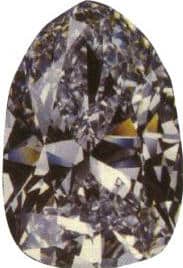
표 5-6 제일 라이트 오브 피스의 완성 다이아몬드 컷팅 개요
| 아니요. | 무게(ct) | 컷 스타일 | 아니요. | 무게(ct) | 컷 스타일 |
|---|---|---|---|---|---|
| 1 | 130.27 | 배 | 8 | 1.83 | 배 |
| 2 | 9.11 | 후작 | 9 | 1.55 | 배 |
| 3 | 9.04 | 후작 | 10 | 1.51 | 배 |
| 4 | 6.93 | 라운드 브릴리언트 | 11 | 1.13 | 배 |
| 5 | 3.63 | 하트 | 12 | 0.81 | 후작 |
| 6 | 3.55 | 타원형 | 13 | 0.37 | 배 |
| 7 | 2.73 | 후작 |
섹션 III 레소토에서 생산된 초대형 다이아몬드
레소토는 아프리카 남부에 위치해 있습니다. 웅장한 산과 독특한 풍경을 자랑하는 나라입니다. 전 세계에서 유일하게 전 국토의 해발 고도가 1,500m 이상인 나라로 "하늘 위의 왕국"이라는 명성을 얻고 있습니다. 국토 면적이 30,344평방킬로미터에 불과하고 남아프리카 공화국에 둘러싸여 있어 세계에서 가장 큰 "나라 속의 나라"입니다. 이 고원 내륙 국가는 험준한 봉우리와 푸른 초원이 펼쳐져 있어 "아프리카의 스위스"라는 별명도 가지고 있습니다.
대형 다이아몬드를 생산하는 렛셍 광산은 해발 3,200m의 북부 목호롱 산맥에 위치해 있으며, 렛셍 다이아몬드 광산은 역사상 가장 높은 생산량을 자랑하는 다이아몬드 광산 중 하나입니다. 렛셍 광산에서 발견된 7개의 초대형 다이아몬드는 모두 렛셍 광산에서 생산되었으며, 그 중 5개는 금세기에 발견되었습니다.
1. 레소토 레전드 다이아몬드

2. 레소토 프로미스 다이아몬드
(1) 레소토 홍보의 발견omise 다이아몬드
레소토 프로미스 다이아몬드는 2006년 8월 22일 레소토의 레셍 다이아몬드 광산에서 603.00캐럿의 무게로 발견되었습니다(그림 5-41). 당시 레소토 천연자원부 장관은 "앞으로 이 다이아몬드와 같거나 더 좋은 다이아몬드를 발견할 것이라는 약속의 의미로 '레소토의 약속'이라고 명명했다"고 말했습니다.

(2) 레소토 프로미스 다이아몬드 거래 및 절단
이 다이아몬드는 2006년 10월 9일 벨기에 앤트워프에서 경매가 진행되었으며, 영국 그라프 다이아몬드가 지분을 보유하고 있는 남아프리카 다이아몬드 회사(SAFDICO)가 $1240만 달러에 매입했습니다. 그 후 그라프는 35명으로 구성된 커팅 팀을 구성하여 회사의 수석 커팅 전문가의 지도 아래 5개월 동안 다이아몬드에 대한 상세한 분석과 연구를 수행했습니다. 그들은 거대한 원석을 26개의 D 컬러의 완벽한 다이아몬드로 성공적으로 정밀하게 커팅하고 연마했습니다: 배 모양 7개, 에메랄드 컷 4개, 라운드 브릴리언트 13개, 마르퀴즈 1개, 하트 1개, 가장 큰 배의 무게는 75캐럿, 가장 작은 배의 무게는 0.55캐럿의 라운드 브릴리언트였습니다. 하나의 러프에서 26개의 D 컬러 무결점 다이아몬드가 생산되었다는 것은 세공팀의 세심한 계획과 정교한 커팅 및 폴리싱 기술을 엿볼 수 있는 대목입니다. 매우 희귀한 마지막 다이아몬드 세트는 "레소토 목걸이"로 명명되었으며 총 무게는 223.35캐럿이었습니다(그림 5-42). 그라프는 "이것은 역사적인 순간입니다. 하나의 다이아몬드가 26개의 D 컬러 무결점 다이아몬드로 커팅된 적은 없었습니다!"라고 외쳤습니다.
당시 이 다이아몬드 목걸이의 가치는 미화 1억 4천만 달러(한화 약 1,500억 원) 이상으로 추정되었습니다.
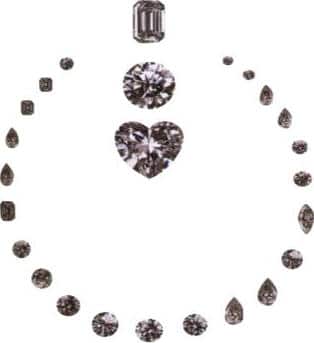
3. 레소토 브라운 다이아몬드
(1) 레소토 브라운 다이아몬드의 발견과 거래
레소토 브라운 다이아몬드는 1967년 레소토의 레셍 다이아몬드 광산에서 발견되었으며, 무게는 601.25캐럿이었습니다(그림 5-43). 이 다이아몬드의 발견은 대형 다이아몬드 생산지로 유명해진 레셍 광산 개발의 시작을 알린 계기가 되었습니다. 이 다이아몬드는 어네스틴 라모보아가 발견한 것으로 알려졌는데, 이는 다이아몬드 발견 역사상 여성이 다이아몬드 원광에서 발견한 다이아몬드 중 가장 큰 다이아몬드입니다. 이 다이아몬드는 그녀의 남편인 페트루스 라모보아를 포함한 가족 4명이 소유하고 있었습니다(그림 5-44). 다이아몬드를 판매하고 안전을 보장하기 위해 페트루스는 직접 당나귀를 타고 수도 마세루까지 운반하여 신뢰할 수 있는 다이아몬드 구매자에게 전달하기로 결정했습니다.

그림 5-43 레소토 브라운 다이아몬드

그림 5-44 레소토 브라운 다이아몬드를 들고 있는 람보 부부
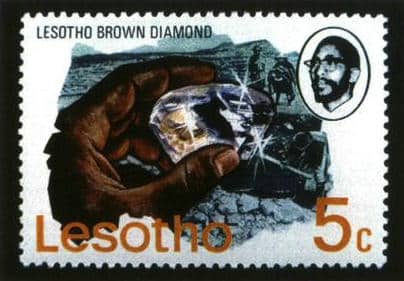
(2) 레소토 브라운 다이아몬드 커팅
1968년 미국 텔레비전 보도에 따르면 해리 윈스턴이 이 다이아몬드를 구입하여 두 개로 쪼개었다고 합니다. 이 다이아몬드는 최종적으로 18개의 완성된 스톤으로 절단되었으며, 가장 큰 4개의 무게는 각각 71.73캐럿, 60.67캐럿, 40.42캐럿, 16.35캐럿으로 레소토 I, 레소토 II, 레소토 III 및 레소토 IV로 명명되었습니다. 가장 큰 레소토 I은 에메랄드 컷 다이아몬드이며, 투명도는 VVS입니다.2약간 분홍빛이 도는 복숭아 색조를 띠고 있습니다(그림 5-46). 2008년 11월 19일, 이 다이아몬드는 제네바에서 열린 소더비 경매에 336만~560만 스위스 프랑의 추정가로 출품되었지만 낙찰되지 못했습니다.
레소토 III는 타원형 컷입니다 (그림 5-47). 해리 윈스턴이 플래티넘 링에 세팅한 이 반지는 그리스의 해운왕 아리스토텔레스 오나시스가 구입하여 케네디 미국 대통령의 미망인 재클린 케네디 오나시스에게 약혼 반지로 선물한 것으로 추정가 $600,000달러에 달합니다. 1996년 4월 재클린 케네디의 유산을 매각할 때 이 다이아몬드 반지의 경매 가격은 $2,587,500에 달했습니다.
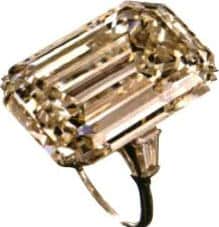
그림 5-46 레소토 I 다이아몬드가 세팅된 반지

그림 5-47 레소토 III 다이아몬드
4. 렛셍 스타 다이아몬드
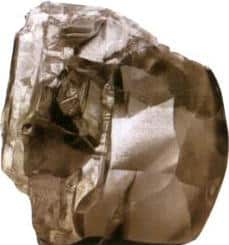
그림 5-48 렛셍 스타 다이아몬드

그림 5-49 렛셍 스타 다이아몬드에서 컷팅한 28개의 폴리싱 다이아몬드
5. 렛셍 레거시 다이아몬드
레셍 레거시 다이아몬드는 2007년에 레소토의 레셍 다이아몬드 광산에서 발견되었으며, 무게는 493.00캐럿이었습니다(그림 5-50). 이 다이아몬드의 이름은 매우 큰 다이아몬드를 생산하는 것으로 유명한 레셍 광산에 대한 찬사를 반영하기도 합니다. 이 다이아몬드는 2007년 11월 벨기에 앤트워프에서 열린 다이아몬드 경매에서 영국 회사 그라프 다이아몬드가 운영하는 남아프리카 공화국 다이아몬드 회사가 1,040만 달러에 매입했습니다.
그라프 다이아몬드는 1년 이상의 세심한 관찰과 연구 끝에 최고급 커팅, 폴리싱 및 세팅 기술을 사용하여 493캐럿의 러프를 우아하고 고귀한 세 가지 주얼리 세트로 성공적으로 변신시켰습니다. 총 132.59캐럿의 배 모양 컷을 한 쌍의 펜던트 이어링(그림 5-51), 라운드 브릴리언트를 센터 스톤으로 하고 배 모양 다이아몬드를 사이드 스톤으로 세팅한 총 43.63캐럿의 다이아몬드 링(그림 5-52), 다양한 컷의 다이아몬드 15개를 세팅한 총 55.61캐럿의 잎 모양의 다이아몬드 브로치(그림 5-53)입니다.

그림 5-50 렛셍 레거시 다이아몬드
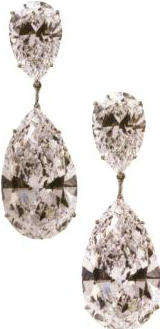
그림 5-51 다이아몬드 펜던트 귀걸이
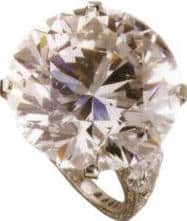
그림 5-52 다이아몬드 반지

그림 5-53 나뭇잎 모양의 다이아몬드 브로치
6. 레셀리 라 레셍 다이아몬드
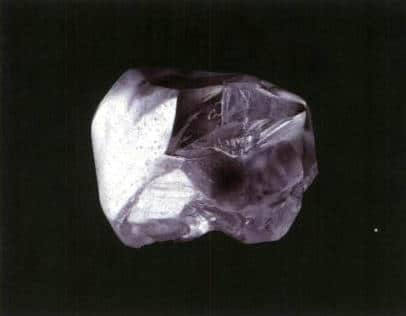
그림 5-54 레셀리 라 레셍 다이아몬드

그림 5-55 그라프 별자리 다이아몬드
카피라이팅 @ 소블링.쥬얼리 - Sobling. 맞춤형 주얼리 제조업체, OEM 및 ODM 주얼리 공장
콩고 민주 공화국에서 생산된 섹션 IV 초대형 다이아몬드
1. 이름 없는 다이아몬드
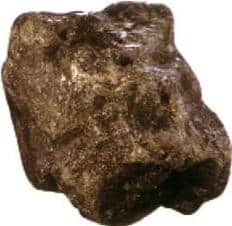
2. 비교할 수 없는 다이아몬드
(1) 비교할 수 없는 다이아몬드의 발견
인컴퍼러블 다이아몬드는 1984년 콩고민주공화국의 음부지-마야 다이아몬드 광산 옆의 잔해 더미에서 한 소녀가 발견했습니다. 원석의 무게는 890캐럿이었고, 절단 및 연마 후 가장 큰 완성품의 무게는 407.48캐럿에 달했습니다(그림 5-57).
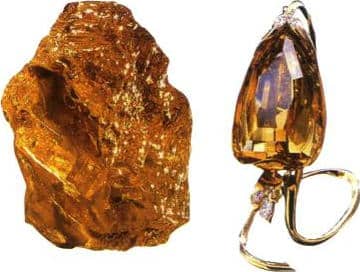
(2) 비교할 수 없는 다이아몬드의 소유자
De Beers의 이사이자 중앙 판매 조직(CSO)의 회장이었던 필립 오펜하이머는 이 다이아몬드를 뉴욕의 다이아몬드 기업인 마빈 사무엘과 루이스 글릭과 함께 공동 소유한 Zale Corporation의 회장인 도널드 제일에게 판매했습니다. 1984년 11월, 이 거대한 다이아몬드는 Zale Corporation 창립 기념일 축하 행사에서 공개되었고 이후 워싱턴 DC의 스미소니언 국립 자연사 박물관에 전시되었습니다.
(3) 비교할 수 없는 다이아몬드의 커팅
인컴퍼러블 다이아몬드의 커팅은 솜메이의 감독 하에 완료되었습니다. 다이아몬드 커터 레오 윈스가 실제 커팅 작업을 수행했습니다. 원석의 모양이 매우 불규칙하고 색상 분포가 매우 고르지 않았기 때문에 4년간의 연구 끝에 다이아몬드는 15개의 완성된 스톤으로 커팅되었습니다. 이 중 가장 큰 다이아몬드는 407.48캐럿의 트리올레트라고 불리는 매우 독특한 컷 모양을 하고 있으며, "비교할 수 없는" 다이아몬드라고 불리는 이 다이아몬드의 색상은 황금빛 노란색이며 1988년 GIA는 투명도를 내부 무결점(IF) 등급으로 평가했습니다. 이 다이아몬드는 현재 골든 주빌리와 컬리넌 I에 이어 무게 기준으로 세계에서 세 번째로 큰 완제품 다이아몬드입니다. 다른 14개의 다이아몬드는 무색에 가까운 색부터 뚜렷한 황갈색까지 다양한 색을 띠고 있습니다. 다이아몬드의 무게는 15.66캐럿, 6.01캐럿, 5.28캐럿, 4.33캐럿, 3.45캐럿, 3.32캐럿, 3.31캐럿, 2.74캐럿(2개), 1.99캐럿, 1.74캐럿, 1.63캐럿, 1.52캐럿, 1.33캐럿입니다.
(4) 비교할 수 없는 다이아몬드 목걸이
2013년 카타르 도하에서 열린 주얼리 및 시계 전시회에서 무아와드 가문의 4대째이자 유명 보석상인 로버트 무아와드의 아들인 프레드 무아와드가 언저러스 다이아몬드 목걸이(그림 5-58)로 멋진 모습을 선보였습니다. 이 네크리스는 총 91개의 다이아몬드와 637캐럿의 로즈 골드 세팅으로 구성되어 있으며, 이 전설적인 네크리스의 펜던트 역할을 하는 인컴퍼러블 다이아몬드가 그 주인공입니다.
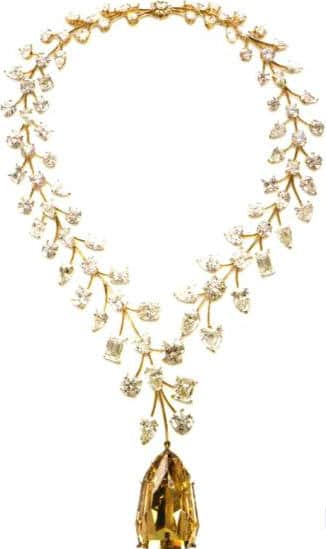
3. 밀레니엄 스타 다이아몬드
(1) 밀레니엄 스타 다이아몬드의 발견
밀레니엄 스타 다이아몬드는 1990년 콩고민주공화국의 음부지-마이이 다이아몬드 광산에서 777캐럿의 무게로 발견되었습니다.
(2) 밀레니엄 스타 다이아몬드 커팅
드 비어는 이 거대한 다이아몬드를 구입한 후 남아프리카, 이스라엘, 벨기에, 미국 출신의 베테랑 절단 전문가들로 구성된 국제적인 절단 팀을 구성했습니다. 다이아몬드를 절단하기 전에 거의 6개월에 걸친 연구를 거쳤으며, 절단 과정에서 시뮬레이션 실험을 위해 원석과 동일한 모양의 플라스틱 모형을 여러 개 제작했습니다. 이 거대한 다이아몬드의 커팅 작업을 완료하는 데 총 3년이 걸렸습니다. 절단 후 다이아몬드의 무게는 203.04캐럿, 총 54개의 면을 가진 배 모양 컷(그림 5-59)으로 제작되었으며, 컬러 등급은 D, 내부 결함 없는(IF) 선명도에 도달했습니다. 드 비어스의 전 회장인 해리 오펜하이머는 이 다이아몬드를 자신이 본 다이아몬드 중 가장 아름다운 다이아몬드라고 묘사한 적이 있습니다.
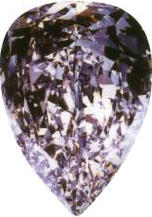
(3) '밀레니엄 다이아몬드' 전시회
On September 8, 1999, De Beers decided to hold an exhibition at the Millennium Dome in London for a group of diamonds named the “Millennium Diamonds” to welcome the new millennium. Nicky Oppenheimer (son of Harry Oppenheimer), then chairman of De Beers, said: “The ‘Millennium Diamonds’ series is so rare and precious; it is the best gift to present to the new millennium.”
The “Millennium Star” diamond is one of the most important exhibits in this “Millennium Diamonds” series exhibition. In addition, there are 11 blue diamonds from the Premier mine in South Africa, cut into various shapes blue diamonds (Fig. 5–60), weighing 5.16~27.64ct, among which the largest one weighs 27.64 ct, is heart-shaped, and is named the “Heart of Eternity.” De Beers invited the famous French film star Sophie Marceau to attend the unveiling of the “Millennium Diamonds.” When she held the “Millennium Star” diamond in her hand, she nearly fainted and exclaimed, “It’s so beautiful.”
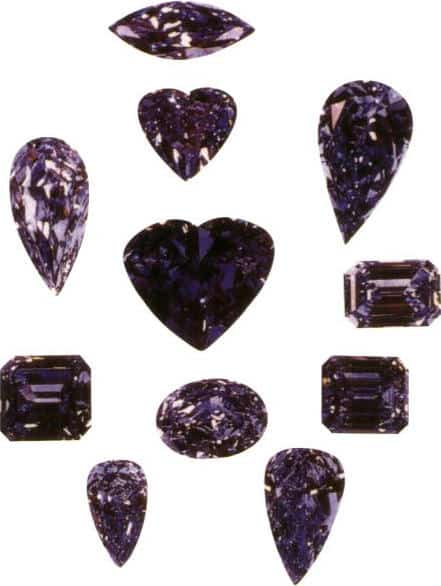
Section V Very Large Diamonds Produced by other African Countries
1. Very Large Diamonds Produced by the Central African Republic

2. Extra-Large Diamonds Produced in Angola

After 11 months of research and evaluation, the diamond was finally cut into a single 163.41 ct emerald-cut diamond (Fig. 5–63), which the GIA certified as a Type IIa diamond, colour D and flawless (FL) clarity.
De Grisogono specially designed an asymmetric platinum necklace for this diamond, called The Art of de Grisogono. The pendant on that necklace is the 163.41 ct emerald-cut diamond, set with four prongs, each prong set with a long step-cut diamond to make the main stone’s fire more vivid and bright; one side of the necklace is composed of 18 graduated long step-cut diamonds, while the other side suspends 66 pear-shaped emeralds, creating a striking contrast with the main diamond (Fig. 5–64).
It is worth mentioning that the back of the pendant hides a detachable mechanism that allows the 163.41 ct diamond to be removed and worn as a bracelet, crown, or brooch. The entire piece took as long as 1,700 hours to create.
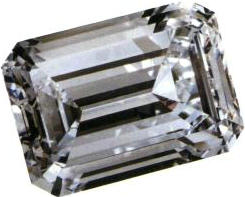
Figure 5-63 4 de Fevereiro diamond (II)

Figure 5-64 The Art of de Grisogono
Section VI Extra-Large Diamonds Produced in Brazil
1. The President Vargas Diamond
(1) Discovery of the President Vargas Diamond
The President Vargas diamond, the rough stone measuring approximately 56mm×51mm×24mm, weighed 726.60 ct. It was discovered on August 13, 1938, in the San Antonio River in the Coromandel district of Minas Gerais, Brazil. It was found on the riverbed by Joaquim Venancio Tiago and Manoel Miguel Domingues, and is the largest diamond discovered in Brazil to date. The diamond was named after the then-President of Brazil, Getulio Dornelles Vargas.
(2) Transactions Involving the Rough President Vargas Diamond
The discoverers of the diamond were eager to sell it; they sold it to a diamond broker for $56,000, and the broker resold the diamond for $235,000. Eventually, the Dutch Union Bank in Amsterdam purchased the diamond. The diamond was taken to the Netherlands and stored in the Dutch Union Bank’s vault. When the famous American jeweller Harry Winston learned of this, he hurried to Amsterdam to negotiate with the diamond’s owner and bought the diamond. At the British insurance company Lloyds, the diamond was insured for $750,000 and, using ordinary registered mail with 75 cents postage, was sent to the company’s headquarters in New York.
(3) Cutting of the President Vargas Diamond
After Harry Winston became the new owner of the diamond, he organised a special diamond-cutting team and spent several months studying the rough diamond, it was decided to cleave it into multiple pieces to obtain high-quality finished diamonds. The cutting and polishing work began in 1941, first sawing off a 20 ct rough diamond from the stone and processing it into one high-quality pear-shaped diamond weighing 10.05ct. Ultimately, this diamond was cut into 29 finished stones, of which 16 were emerald cuts, 10 were trilliant cuts, and one each pear, marquise, and cushion. The total weight of the finished diamonds was 411.06 ct, and the yield was 56.57%. The largest of these weighed 48.26 ct, was emerald cut, and was still named the “President Vargas” diamond.
(4) Transactions after Cutting and Polishing of the President Vargas Diamond
In 1944, Harry Winston sold the President Vargas diamond to a wealthy businessman in Fort Worth, Texas. Later, in 1958, it was repurchased and reworked again, reducing its weight to 44.17 ct, but improving its clarity to Internally Flawless (IF), and in 1961, it was sold again to an anonymous collector. Currently, the diamond is part of the collection of the famous jeweller Robert Mouawad. At the Sotheby’s auction in New York in April 1989, he also bought the President Vargas IV diamond, weighing 27.33 ct, for $781,000. The President Vargas VI diamond, weighing 25.4 ct, was sold at Sotheby’s in New York in October 1992 for $396,000.
2. Other Very Large Diamonds Produced in Brazil
(1) Darcy Vargas Diamond
The Darcy Vargas diamond, discovered on July 8, 1939, was found in the São Antônio River in the Coromandel district of Minas Gerais, Brazil, just 2 km from the site where the Vargas President diamond was found. The diamond is named after Darcy Vargas, the wife of then-president Getúlio Dornelles Vargas. The rough stone was irregular in shape, weighed 455 ct, and was brown in colour. In the early 1940s, it was exhibited in New Haven, Connecticut, USA.
(2) Charncca I Diamond
The Charncca I diamond was discovered in 1940 in the Santo Inácio River in the Coromandel district of Minas Gerais, Brazil, and weighed 428 ct.
(3) President Dutra Diamond
The President Dutra diamond, 1949, was found in the Dourados River in the Abadia district of Minas Gerais, Brazil by a local farmer. The diamond’s name comes from then-Brazilian President Eurico Gaspar Dutra (Eurico Gaspar Dutra). The rough stone weighed 407.68 ct. It was cut into 36 finished diamonds with a total weight of 136 ct, yielding a material recovery rate of 33.36%. The largest finished diamond weighs 9.60 ct and is still called the President Dutra Diamond; the smallest weighs 0.55 ct.
(4) Coromandel VI Diamond
The Coromandel VI diamond, discovered in 1948 in the Coromandel district of Minas Gerais, Brazil, weighs 400.65 ct.
Section VII Extra-Large Diamonds Produced in India
1. The Great Mughal Diamond
(1) The Past Life of the Great Mogul Diamond
The Great Mogul diamond was discovered in India and has a long history. The diamond was named by the Mughal dynasty ruler Akbar; during 1656–1657, Shah Jahan of the Mughal dynasty came into possession of it. At that time, it was the largest diamond known to have been found in the world. In November 1665, the famous French jeweller and traveller Jean Baptiste Tavernier (Figure 5–65), at the invitation of the Mughal dynasty’s sixth emperor, Aurangzeb, was permitted to examine and test (including weighing) the diamond. Unfortunately, after Tavernier examined the stone, all traces of it suddenly disappeared. According to Tavernier’s description, the diamond’s size was similar to a small egg, while its shape was like a half-egg (Figure 5–66).
Tavoni once carefully examined the Great Mogul diamond, and he recorded: “The first diamond placed in my hand was a large stone cut into a round rose shape. On one side of the diamond there is a small notch, and internally there is an inclusion; the diamond is of high-quality water (color)…”
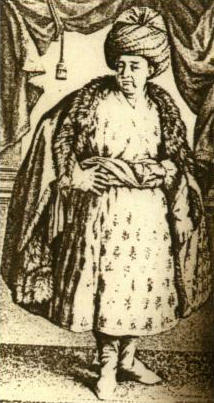
Figure 5-65 Jean Baptiste Tavernier

Figure 5-66 Cut diagram of the Great Mogul diamond
(2) The Present Form of the Great Mogul Diamond
After that, the diamond passed through the hands of several rulers of the Mughal dynasty. The Soviet mineralogist E. A. Fersman once thought the Great Mogul diamond was the famous Koh-i-Noor, and later believed it was the Dayya-i-Noor diamond belonging to the Iranian royal family, but that was not the case. Some thought the missing Great Mogul diamond was the Orloff diamond, but that can only be speculation.
The Great Mogul diamond, the Koh-i-Noor, and the Orloff are only similar in shape; in essence, they are three different diamonds, with obvious differences in weight. In that era, Tavoni was recognised as a diamond merchant with extensive knowledge of diamonds; his descriptions and records of diamonds are reliable. As a diamond merchant, he was extremely sensitive to a diamond’s weight and would not be mistaken about it.
Tavoni believed that when the Great Mogul diamond came into the hands of Shah Jahan, the rough stone weighed 900 ratis, equivalent to 787.50 ct. However, when Tavoni saw the diamond, it had already been cut by the Venetian diamond cutter Hortensio Borgio, and its weight had been reduced to only 319.5 ratis, equivalent to 280 ct. The Koh-i-Noor’s weight is 186 ct, and the Orloff’s weight is 193 ct; the weight differences among the three diamonds are clear. Borgio’s poor workmanship caused the diamond to lose too much weight; the king of Oran not only did not pay him his fee, but fined him 10,000 rupees, which was all the money Borgio had with him; otherwise, he would have been fined even more.
Borgio was a cutter of limited skill; Tavoni believed his understanding and study of diamonds were not thorough. If he had been able to cleave a large piece off the rough along the stone’s cleavage planes, he would not have created so many problems in the subsequent cutting and polishing, and perhaps he would have earned the wages that were due him. Although Indian diamond cutters at the time could cleave and cut diamonds, the traditional Indian polishing techniques were inferior, which may have been the reason they commissioned the European cutter Borgio for the job.
2. The Nizam Diamond
3. The Pitt Diamond
(1) The Discovery of the Pitt Diamond
The Pitt diamond was discovered in 1701 by a miner working at the Partial diamond mine on the Krishna River in Golconda, India; the rough stone weighed 410ct. The miner who found the diamond did not want to hand it over and attempted to flee with it. To conceal it, he wounded his own calf and hid the diamond under the bandaged dressing, eluding strict supervision and escaping to the coast. He confided the secret to a British captain anchored there and proposed to share the proceeds of the diamond’s sale on the condition that the captain take him out of the country. The captain feigned agreement, but during the voyage, he secretly took the diamond and threw the discoverer into the vast sea.
(2) The Trade and Cutting of the Pitt Diamond
It is said the captain sold the diamond to the merchant Jamchund for £1,000. Later, Thomas Pitt, Governor of Madras, bought the diamond for £24,000 and named it the Pitt diamond. The diamond was shipped to London on the merchant ship Bedford. In London, the stone was recut by Joseph Cope, reducing its weight from 410 ct to 400.5 ct; the cutting cost £5,000, a considerable sum in the early 18th century. After cutting, a small inclusion remained on the surface, which could be concealed by mounting, and two internal flaws were difficult to see with the naked eye.
Subsequently, the Pitt diamond was recut again. After recutting, the weight was reduced to only 140.50ct, fashioned into a cushion cut, measuring approximately 32mm×34mm×25mm; the cutting took nearly two years and cost $25,000. The smaller diamonds produced in the cutting were sold for $35,000, and some of the rose-cut stones were bought by Peter the Great of Russia. The recut Pitt diamond became a high-quality brilliant-cut gem. Its price was steep, making it difficult to sell, while at the same time, the public was eager to see this incomparable treasure, spurring countless legends. Pitt was therefore very worried about theft and kept the diamond on his person at all times, frequently changing his residence for security. In short, the diamond exhausted Pitt, and anxious to rid himself of the burden, he hurried to sell it, even making a lead model of the stone. The high price put off many European royals; Louis XIV of France, a jewellery lover, lacked the funds to purchase the rare gem. After Louis XIV’s death, his five-year-old great-grandson ascended the French throne, with Philippe II, Duke of Orléans, acting as regent. To display his power, he paid £135,000 for the diamond and renamed it the Regent Diamond (Fig. 5-67). Pitt paid a £5,000 commission to sell the stone, and the successful transaction relieved him of his heavy psychological burden.

(3) History of the Regent Diamond
In 1772, at the coronation of Louis XV, the Regent Diamond was set in his crown. The queen, Leszczyńska, also frequently wore this diamond. In 1792, the Regent Diamond, along with other jewels of the French royal family, including the Mirror of Portugal diamond, the Sancy diamond, and others, was stolen; after more than a year, the Regent Diamond was found in a crack in the attic of a timber-framed house in Paris. Thus, the diamond returned to the French royal treasure. The Regent Diamond is a beautiful, high-quality diamond.
In 1799, Napoleon Bonaparte proclaimed himself First Consul, and the French crown jewels were used as collateral for various fundraisings. Officers in Napoleon’s army personally pawned many diamonds, including the Regent Diamond and the famous Sancy Diamond, obtaining the necessary loans from Berlin and Madrid, respectively.
The armies led by Napoleon conquered Italy and brought back large quantities of precious metals and gemstones, and France’s treasure trove began to grow again. Napoleon also redeemed most of the diamonds that had been pawned or mortgaged, including the RégentRégent Diamond; he set this diamond into the guard of a sword, alongside two diamonds of about 16.5 ct each. In 1804, after Napoleon declared himself Emperor, he wore a crown once worn by the Virgin Mary and carried a sceptre set with the RégentRégent Diamond at his coronation.
After a series of wars, Napoleon controlled much of Europe. He divorced Josephine and married Marie Louise. For their wedding, France purchased a large amount of jewellery. Afterwards, the sword bearing the Regent Diamond was dismantled and the diamond was mounted on a newly made sword, surrounded by rose-cut diamonds and other stones. Napoleon rebuilt a considerably rich jewellery collection for France, which, after the accession of Louis XVIII, once again became known as the French crown jewels. At the Battle of Waterloo, Napoleon was defeated, and subsequently, Charles X set the Regent Diamond into the crown.
Thereafter, the French crown jewels remained relatively undisturbed for a time. In 1848, the French Second Republic was established, but the royal jewels were not destroyed. When Napoleon III married Eugénie, France’s jewellery collection was quite abundant; the royal jewellers Messrs Bapst designed a new crown for Empress Eugénie, which was set with the Regent Diamond.
After the establishment of the French Third Republic, at the end of 1886, on the proposal of Benjamin Raspail, a decision was made to entrust jewels of historical, scientific, and artistic value respectively to the Natural History Museum, the School of Mines, and the Louvre, and to sell the remainder by public auction. This decision was disastrous for the long-standing French royal jewels; besides economic reasons, there were perhaps political motives as well — namely, to eradicate the power and symbols of the French Empire.
From May 12 to 23, 1883, the French royal jewellery was publicly auctioned, jewellers from around the world competing to bid. A total of 54,403 brilliant-cut diamonds, 21,119 rose-cut diamonds, 2,963 pearls, 507 rubies, 312 emeralds and 136 sapphires were sold, most of which were acquired by Tiffany of New York; fortunately, the Regent Prince’s diamonds—because of their high historical value—were not included on the auction list.
During World War II, the German army occupied France. Before the fall of Paris in 1940, the French government hid the Regent Diamond behind an inconspicuous panel in the Château de Chambord on the banks of the Loire. Reichsmarschall Göring threatened by force, demanding the diamond, but did not succeed. In 1945, the Regent Diamond returned to the Apollo Gallery of the Louvre. In January 1962, at the centennial exhibition of French jewellery held at the Louvre, the Regent Diamond was displayed together with the Sancy Diamond and the Hope Diamond — their first “reunion” since they were stolen from the French crown jewels in 1792.
Section VIII Extra-Large Diamonds Produced in Canada








